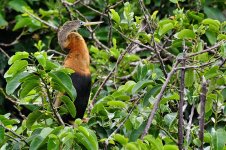Zackiedawg
Well-known member
Among dozens of nesting anhingas in Delray Beach, FL, most of which are typical all-black males or half-black, half-buff-necked females...or the downy white juveniles...I spotted one that stood out quite a bit. I can't figure out if this is a known or normal variant color for anhingas, a more rare anomalous color, just an odd fluke, or if this was a hybrid or different species than the 'anhinga anhinga'. The reddish to chestnut color on the lower part of the neck and chest were very vivid and noticeable even from 70+ feet away. I've included a photo if anyone can clarify if this was common, rare, or something new.






